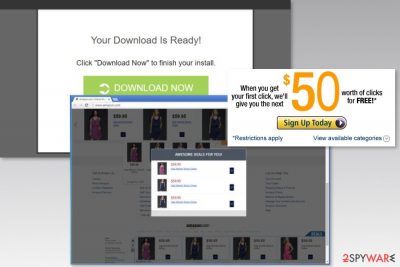D2ucfwpxlh3zh3.cloudfront.net (Removal Guide) - May 2018 update
D2ucfwpxlh3zh3.cloudfront.net Removal Guide
What is D2ucfwpxlh3zh3.cloudfront.net?
D2ucfwpxlh3zh3.cloudfront.net – redirect virus that has been causing browsing-related problems

D2ucfwpxlh3zh3.cloudfront.net is a domain used by a potentially unwanted program (PUP) that is designed to display ads, trigger redirects and track information about users. The research has shown that it is identical to D2pezc1a2cl20m.cloudfront.net virus and belongs to the same Cloudfront adware group.
However, we want to stress out that the original Cloudfront.net service is legit and owned by Amazon corporation.[1] The problem is that crooks use this content delivery network for their shady activities. Most of the time they just want to generate as much pay-per-click-revenue as possible. However, adware might also be used for spreading malicious ads.
Usually, D2ucfwpxlh3zh3.cloudfront.net ads appear after incorrect installation of freeware or shareware. Adware might modify Windows registry and alter each browser’s installed on the affected computer settings, including Chrome, Firefox, Explorer or Safari.
The D2ucfwpxlh3zh3.cloudfront.net adware is capable of using a virtual layer to display third-party commercial content on the websites you visit. These offers might suggest downloading security programs, getting discount coupons, etc. Though, the majority of them are fake.[2] However, clicking these offers is not recommended due to redirect tendencies. Some of the ads might be malicious and infect your PC with malware, trojans and other cyber threats.
This domain is also known for promoting hohosearch.com which is a highly questionable search tool that operates as a browser hijacker. While these redirects are more annoying than dangerous, the ad-supported application might also reroute to technical support scam or phishing sites.
For this reason, D2ucfwpxlh3zh3.cloudfront.net removal is recommended as soon as first ads show up on the screen. They are not hard to identify – they are aggressive, cover needed content, and include the name of the adware at the bottom of the advert.
The quickest way to remove D2ucfwpxlh3zh3.cloudfront.net adware is to scan the system with anti-malware software, like FortectIntego. However, you can terminate PUP manually by following our prepared guide as well.

Dissemination methods of the ad-supported applications
D2ucfwpxlh3zh3.cloudfront.net hijack usually occurs when users download free programs incorrectly. By saying incorrectly, we have in mind “Quick” or “Standard” installation settings. The problem with them is that they do not openly disclose about third-party apps that might be attached to the primary program. According to No Virus[3] researchers, the quick installation method is popular among computer users.
Any freeware or shareware often promotes software that usually belongs to the group of PUPs. Thus, to avoid installation of undesired apps, you should use “Advanced” or “Custom” settings and monitor the process. Once you see the checkbox with pre-selected additional downloads, remove those ticks.
Eliminate D2ucfwpxlh3zh3.cloudfront.net adware
One of the ways how you can remove D2ucfwpxlh3zh3.cloudfront.net ads is to investigate the system. It means you have to check previously installed programs and browser extensions and find the most suspicious ones among them. Once you delete all suspicious entries, you should reset each of your web browsers as well.
If manual D2ucfwpxlh3zh3.cloudfront.net removal guide below seems too complicated or time-consuming for you, you should opt for the automatic elimination option. This option requires only downloading one of programs that we recommend bellow, scanning the system and deleting detected entries.
You may remove virus damage with a help of FortectIntego. SpyHunter 5Combo Cleaner and Malwarebytes are recommended to detect potentially unwanted programs and viruses with all their files and registry entries that are related to them.
Getting rid of D2ucfwpxlh3zh3.cloudfront.net. Follow these steps
Uninstall from Windows
Follow these steps to get rid of D2ucfwpxlh3zh3.cloudfront.net adware from Windows:
Instructions for Windows 10/8 machines:
- Enter Control Panel into Windows search box and hit Enter or click on the search result.
- Under Programs, select Uninstall a program.

- From the list, find the entry of the suspicious program.
- Right-click on the application and select Uninstall.
- If User Account Control shows up, click Yes.
- Wait till uninstallation process is complete and click OK.

If you are Windows 7/XP user, proceed with the following instructions:
- Click on Windows Start > Control Panel located on the right pane (if you are Windows XP user, click on Add/Remove Programs).
- In Control Panel, select Programs > Uninstall a program.

- Pick the unwanted application by clicking on it once.
- At the top, click Uninstall/Change.
- In the confirmation prompt, pick Yes.
- Click OK once the removal process is finished.
Delete from macOS
Adware might affect Mac OS X as well. Thus, if you are bothered by an excessive amount of shady ads, follow these steps to fix the problem:
Remove items from Applications folder:
- From the menu bar, select Go > Applications.
- In the Applications folder, look for all related entries.
- Click on the app and drag it to Trash (or right-click and pick Move to Trash)

To fully remove an unwanted app, you need to access Application Support, LaunchAgents, and LaunchDaemons folders and delete relevant files:
- Select Go > Go to Folder.
- Enter /Library/Application Support and click Go or press Enter.
- In the Application Support folder, look for any dubious entries and then delete them.
- Now enter /Library/LaunchAgents and /Library/LaunchDaemons folders the same way and terminate all the related .plist files.

Remove from Microsoft Edge
Delete unwanted extensions from MS Edge:
- Select Menu (three horizontal dots at the top-right of the browser window) and pick Extensions.
- From the list, pick the extension and click on the Gear icon.
- Click on Uninstall at the bottom.

Clear cookies and other browser data:
- Click on the Menu (three horizontal dots at the top-right of the browser window) and select Privacy & security.
- Under Clear browsing data, pick Choose what to clear.
- Select everything (apart from passwords, although you might want to include Media licenses as well, if applicable) and click on Clear.

Restore new tab and homepage settings:
- Click the menu icon and choose Settings.
- Then find On startup section.
- Click Disable if you found any suspicious domain.
Reset MS Edge if the above steps did not work:
- Press on Ctrl + Shift + Esc to open Task Manager.
- Click on More details arrow at the bottom of the window.
- Select Details tab.
- Now scroll down and locate every entry with Microsoft Edge name in it. Right-click on each of them and select End Task to stop MS Edge from running.

If this solution failed to help you, you need to use an advanced Edge reset method. Note that you need to backup your data before proceeding.
- Find the following folder on your computer: C:\\Users\\%username%\\AppData\\Local\\Packages\\Microsoft.MicrosoftEdge_8wekyb3d8bbwe.
- Press Ctrl + A on your keyboard to select all folders.
- Right-click on them and pick Delete

- Now right-click on the Start button and pick Windows PowerShell (Admin).
- When the new window opens, copy and paste the following command, and then press Enter:
Get-AppXPackage -AllUsers -Name Microsoft.MicrosoftEdge | Foreach {Add-AppxPackage -DisableDevelopmentMode -Register “$($_.InstallLocation)\\AppXManifest.xml” -Verbose

Instructions for Chromium-based Edge
Delete extensions from MS Edge (Chromium):
- Open Edge and click select Settings > Extensions.
- Delete unwanted extensions by clicking Remove.

Clear cache and site data:
- Click on Menu and go to Settings.
- Select Privacy, search and services.
- Under Clear browsing data, pick Choose what to clear.
- Under Time range, pick All time.
- Select Clear now.

Reset Chromium-based MS Edge:
- Click on Menu and select Settings.
- On the left side, pick Reset settings.
- Select Restore settings to their default values.
- Confirm with Reset.

Remove from Mozilla Firefox (FF)
Follow these steps to clean Mozilla Firefox from potentially unwanted programs:
Remove dangerous extensions:
- Open Mozilla Firefox browser and click on the Menu (three horizontal lines at the top-right of the window).
- Select Add-ons.
- In here, select unwanted plugin and click Remove.

Reset the homepage:
- Click three horizontal lines at the top right corner to open the menu.
- Choose Options.
- Under Home options, enter your preferred site that will open every time you newly open the Mozilla Firefox.
Clear cookies and site data:
- Click Menu and pick Settings.
- Go to Privacy & Security section.
- Scroll down to locate Cookies and Site Data.
- Click on Clear Data…
- Select Cookies and Site Data, as well as Cached Web Content and press Clear.

Reset Mozilla Firefox
If clearing the browser as explained above did not help, reset Mozilla Firefox:
- Open Mozilla Firefox browser and click the Menu.
- Go to Help and then choose Troubleshooting Information.

- Under Give Firefox a tune up section, click on Refresh Firefox…
- Once the pop-up shows up, confirm the action by pressing on Refresh Firefox.

Remove from Google Chrome
If Chrome has been interrupting you with D2ucfwpxlh3zh3.cloudfront.net ads, follow this guide to fix the problem:
Delete malicious extensions from Google Chrome:
- Open Google Chrome, click on the Menu (three vertical dots at the top-right corner) and select More tools > Extensions.
- In the newly opened window, you will see all the installed extensions. Uninstall all the suspicious plugins that might be related to the unwanted program by clicking Remove.

Clear cache and web data from Chrome:
- Click on Menu and pick Settings.
- Under Privacy and security, select Clear browsing data.
- Select Browsing history, Cookies and other site data, as well as Cached images and files.
- Click Clear data.

Change your homepage:
- Click menu and choose Settings.
- Look for a suspicious site in the On startup section.
- Click on Open a specific or set of pages and click on three dots to find the Remove option.
Reset Google Chrome:
If the previous methods did not help you, reset Google Chrome to eliminate all the unwanted components:
- Click on Menu and select Settings.
- In the Settings, scroll down and click Advanced.
- Scroll down and locate Reset and clean up section.
- Now click Restore settings to their original defaults.
- Confirm with Reset settings.

Delete from Safari
Remove unwanted extensions from Safari:
- Click Safari > Preferences…
- In the new window, pick Extensions.
- Select the unwanted extension and select Uninstall.

Clear cookies and other website data from Safari:
- Click Safari > Clear History…
- From the drop-down menu under Clear, pick all history.
- Confirm with Clear History.

Reset Safari if the above-mentioned steps did not help you:
- Click Safari > Preferences…
- Go to Advanced tab.
- Tick the Show Develop menu in menu bar.
- From the menu bar, click Develop, and then select Empty Caches.

After uninstalling this potentially unwanted program (PUP) and fixing each of your web browsers, we recommend you to scan your PC system with a reputable anti-spyware. This will help you to get rid of D2ucfwpxlh3zh3.cloudfront.net registry traces and will also identify related parasites or possible malware infections on your computer. For that you can use our top-rated malware remover: FortectIntego, SpyHunter 5Combo Cleaner or Malwarebytes.
How to prevent from getting adware
Choose a proper web browser and improve your safety with a VPN tool
Online spying has got momentum in recent years and people are getting more and more interested in how to protect their privacy online. One of the basic means to add a layer of security – choose the most private and secure web browser. Although web browsers can't grant full privacy protection and security, some of them are much better at sandboxing, HTTPS upgrading, active content blocking, tracking blocking, phishing protection, and similar privacy-oriented features. However, if you want true anonymity, we suggest you employ a powerful Private Internet Access VPN – it can encrypt all the traffic that comes and goes out of your computer, preventing tracking completely.
Lost your files? Use data recovery software
While some files located on any computer are replaceable or useless, others can be extremely valuable. Family photos, work documents, school projects – these are types of files that we don't want to lose. Unfortunately, there are many ways how unexpected data loss can occur: power cuts, Blue Screen of Death errors, hardware failures, crypto-malware attack, or even accidental deletion.
To ensure that all the files remain intact, you should prepare regular data backups. You can choose cloud-based or physical copies you could restore from later in case of a disaster. If your backups were lost as well or you never bothered to prepare any, Data Recovery Pro can be your only hope to retrieve your invaluable files.
- ^ What Is Amazon CloudFront?. AWS Documentation. Amazon Web Services.
- ^ Todd Haselton. A fake Amazon ad tried to scam users before Black Friday. CNBC. News website.
- ^ No Virus. No Virus. Security and spyware news.























